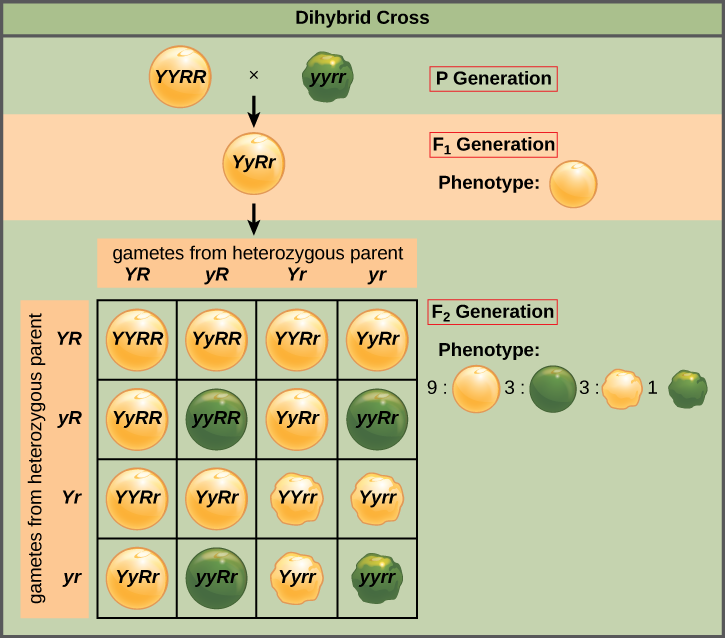| << Chapter < Page | Chapter >> Page > |
Mendel’s law of independent assortment states that genes do not influence each other with regard to the sorting of alleles into gametes, and every possible combination of alleles for every gene is equally likely to occur. The independent assortment of genes can be illustrated by the dihybrid cross, a cross between two true-breeding parents that express different traits for two characteristics. Consider the characteristics of seed color and seed texture for two pea plants, one that has green, wrinkled seeds ( yyrr ) and another that has yellow, round seeds ( YYRR ). Because each parent is homozygous, the law of segregation indicates that the gametes for the green/wrinkled plant all are yr , and the gametes for the yellow/round plant are all YR . Therefore, the F 1 generation of offspring all are YyRr ( [link] ).

In pea plants, purple flowers (P) are dominant to white flowers (p) and yellow peas (Y) are dominant to green peas (y). What are the possible genotypes and phenotypes for a cross between PpYY and ppYy pea plants? How many squares do you need to do a Punnett square analysis of this cross?
For the F2 generation, the law of segregation requires that each gamete receive either an R allele or an r allele along with either a Y allele or a y allele. The law of independent assortment states that a gamete into which an r allele sorted would be equally likely to contain either a Y allele or a y allele. Thus, there are four equally likely gametes that can be formed when the YyRr heterozygote is self-crossed, as follows: YR , Yr , yR , and yr . Arranging these gametes along the top and left of a 4 × 4 Punnett square ( [link] ) gives us 16 equally likely genotypic combinations. From these genotypes, we infer a phenotypic ratio of 9 round/yellow:3 round/green:3 wrinkled/yellow:1 wrinkled/green ( [link] ). These are the offspring ratios we would expect, assuming we performed the crosses with a large enough sample size.
Because of independent assortment and dominance, the 9:3:3:1 dihybrid phenotypic ratio can be collapsed into two 3:1 ratios, characteristic of any monohybrid cross that follows a dominant and recessive pattern. Ignoring seed color and considering only seed texture in the above dihybrid cross, we would expect that three quarters of the F 2 generation offspring would be round, and one quarter would be wrinkled. Similarly, isolating only seed color, we would assume that three quarters of the F 2 offspring would be yellow and one quarter would be green. The sorting of alleles for texture and color are independent events, so we can apply the product rule. Therefore, the proportion of round and yellow F 2 offspring is expected to be (3/4) × (3/4) = 9/16, and the proportion of wrinkled and green offspring is expected to be (1/4) × (1/4) = 1/16. These proportions are identical to those obtained using a Punnett square. Round, green and wrinkled, yellow offspring can also be calculated using the product rule, as each of these genotypes includes one dominant and one recessive phenotype. Therefore, the proportion of each is calculated as (3/4) × (1/4) = 3/16.

Notification Switch
Would you like to follow the 'Biology' conversation and receive update notifications?